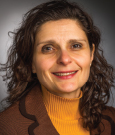One of the most important cancer survivorship issues is the transition from oncologist to the primary care setting. With a growing population of cancer survivors, patients need to feel secure about their primary care provider having the tools to address their special needs. To shed light on this important issue, The ASCO Post spoke with Larissa Nekhlyudov, MD, MPH, Associate Professor in the Department of Population Medicine, Harvard Medical School, Boston. Dr. Nekhlyudov is a primary care provider specializing in caring for cancer survivors.
Dual Focus
Please tell the readers a bit about your background and your current position.
After medical school, I did my residency and internship in internal medicine and then pursued a research fellowship focusing on breast cancer screening. After my fellowship, I joined the faculty at Harvard Medical School, where I primarily did research across the entire spectrum of cancer care, while still practicing general internal medicine.
More recently, I’ve have taken on a role as a medical provider for adult survivors of childhood cancer at the Dana-Farber Cancer Institute’s David B. Perini, Jr. Quality of Life Clinic. In this consultative role, I address patients’ long-term survivorship needs, which include surveillance for recurrences, monitoring for late and long-term effects of cancer therapies, psychosocial issues, and health promotion.
Making the Transition
What sparked your interest in the transition of cancer patients from the oncology setting to the primary care setting?
I’ve been a practicing primary care physician at Harvard Vanguard Medical Associates in Boston since 1999. I care for adult patients with a variety of medical conditions. About 10 years ago, my cancer care research began to focus more on treatment and survivorship.
As I gained expertise in cancer survivorship, I began getting referrals from our local oncologists of patients who had successfully undergone cancer therapy. In some ways, I became the designated primary care provider for cancer survivors, since the local oncologists felt very comfortable transitioning their patients to me.
Not-So-Seamless Transition
In theory, the interaction between oncologist and primary care physician should be a seamless transition with valuable interaction. As one who has successfully bridged the gap between the two disciplines, what have you found?
One would think that the interaction between oncology and primary care, given the delicate transition needs of the patients, would be seamless, but that’s not the case. Once the cancer diagnosis is made and the patient is referred to an oncology team, there is usually some back and forth among the oncology team and the primary care provider.
As time goes on, the patient gets totally drawn into the oncology setting, which has multiple providers, so the primary care doctor begins to fall out of the care loop. At that point in the care continuum, there is very little communication between the oncology provider and the primary care doctor. Many times, it’s up to the patient to make sure that all the parties involved are on the same page.
Models for Continuity
In your recent paper in The Oncologist,1 you describe models for involving primary care in cancer survivorship. Please describe them.
The ideal model is one in which the primary care provider is affiliated with a cancer center and engages in the care of the patient from time of diagnosis and into the survivorship phase of care. In this model, the primary care physician needs an in-depth understanding of the implications of cancer and also of the treatments that are given.
Moreover, the primary care physician must have knowledge of surveillance for recurrence and skills for monitoring and managing issues in late-stage disease. Working together, the oncologist and primary care doctor can also put together individualized survivorship care plans, which includes the interaction of cancer-related and comorbid medical conditions. Although this is the optimal model for integrating primary care into cancer care, it isn’t feasible in most settings.
The other model also includes an expert primary care provider with training in survivorship care, but instead of being embedded in the continuity of care, the provider acts more as a consultant as patients complete therapy and transition to survivorship. As part of the consultative model, the primary care provider maintains communication with the oncologist.
That said, there is a role for the primary care physician who has no training in cancer care but has an interest in patients who are transitioning into the survivorship phase. When transitioning from active care, patients can choose such primary care providers, which will help ease the anxiety of transitioning from the oncologist. These relationships can begin a shared organic process during which the primary care doctor learns about survivorship needs as the process evolves.
Given the growing survivorship population and the workforce challenges in both oncology and primary care, it becomes increasingly important for the two disciplines to communicate and help each other care for the multiple needs involved in cancer survivorship.
Moving forward, it is probably a good idea to add more oncology courses into the general internist and primary care curriculum. Primary care doctors will never get involved in oncologic therapy decisions, but a deeper awareness of how cancer and its treatments affect their patients is needed.
Looking Ahead
Please give the readers a last thought or two about this valuable issue, and where you see this important continuum-of-care issue progressing.
The growing population of cancer survivors presents a challenge to the cancer care delivery system, which, in many areas of practice, is understaffed and overworked. Moving forward, the oncology community will need a concerted effort to ensure that their patients receive the high-quality care they deserve. One way to handle this challenge is to have a more active involvement of primary care physicians in cancer survivorship programs. ■
Disclosure: Dr. Nekhlyudov reported no potential conflicts of interest.
Reference
1. Nekhlyudov L: Integrating primary care in cancer survivorship programs: Models of care for a growing patient population. Oncologist 19:579-582, 2014.


